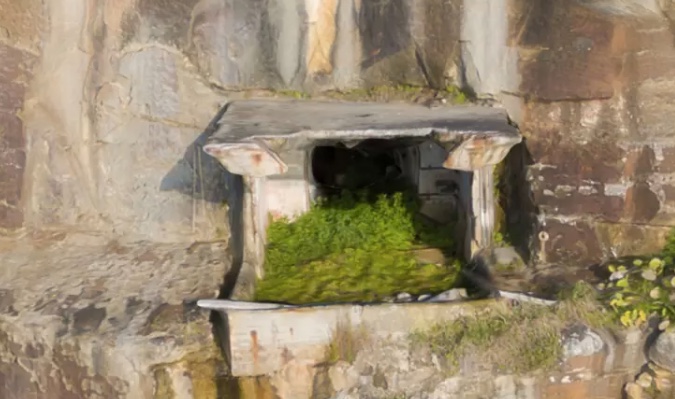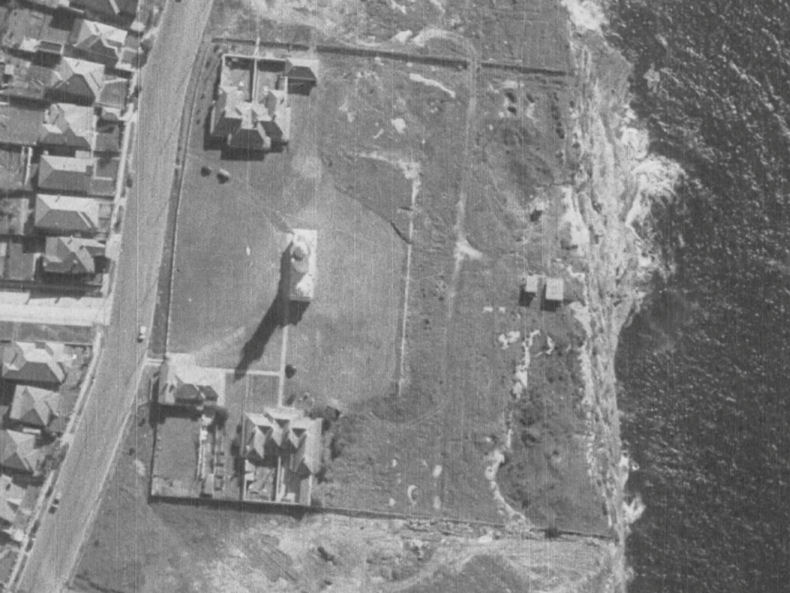SIGNAL BATTERY
SOUTH HEAD, SYDNEY, NSW
DURING WWII
![]()
Signal Battery was built at South Head adjacent to the Signal Station on the cliffs at Vaucluse to cover the entrance to Sydney Harbour, New South Wales to supplement the relocated 6" guns at Hornby Battery. Two BL 6" Mk XI guns became operational at Signal Battery in 1940.
When WWII was declared in Europe the guns were manned by a mixed crew of permanent and militia troops until October 1940 when an integrated Signal Battery was formed to man the guns.
The Signal Battery became a training battery in April 1943 and was no longer under the operational control HQ Sydney Fixed Defences. The RAE soldiers of the 126th CASL Section which had been attached to the battery were transferred to RAA in May 1943 and were then absorbed into the Signal Battery in October 1943.
On 27 September 2018, an article in the Sydney Morning Herald featured the story of what appeared to be a tunnel entrance in the cliff below the Macquarie Lighthouse. The tunnel opening had been discovered by the use of a drone. It showed a small concrete opening about 150 feet down from the top of the cliff. Despite the fact that it is not far from the former Macquarie Battery, it is believed that this would have been a searchlight emplacement built in support of the Signal Battery about 450 metres further north long the cliff coastline. There is a file in National Archives titled "Coast Defence projects: installation of searchlight and engine room emplacements at 5.25" CA/AA battery at Christison Park, N.S.W."
There was a vertical access shaft 120 feet high to access the 60 foot long tunnel to the searchlight emplacement in the cliff face. Iron rung ladders were used in the vertical shaft for access.
On 15 February 1948 two boys, Norman Brown, and Barry Reynolds, both aged 13 years, climbed down the iron rung ladder in the 120 foot vertical shaft (some newspaper reports said it was 60 feet deep) and accessed the searchlight emplacement in the cliff face. Norman Brown crawled over the 3 foot wall of the emplacement and slithered down a rope to a narrow ledge 30 feet below the emplacement. Whilst attempting to climb back up the rope he lost his grip and fell about 8 to 10 feet down to the narrow ledge. Barry Reynolds climbed back up the iron rung ladder and sought assistance from someone in the military reserve. Bombardier Lloyd Humphreys responded and climbed down the 120 shaft and tried to pull Brown back up into the emplacement but the boy was too scared to hold on to the rope. Bombardier Humphreys told Brown to stay still on the ledge until Police arrived with rescue equipment. Sergeant Walden and Constables Beer, Thomas, Louis and Paton from the NSW Police arrived and Walden lowered a thicker rope down to the boy. Norman Brown then sat in a loop formed in the thicker rope and was pulled up to the emplacement by Sgt. Walden.
Well known Professor of Physics at Sydney University, Harry Messel, received permission from the Australian Army in about 1955 to do cosmic ray research in the 60 foot long searchlight tunnel. He wanted to find out the effect of cosmic rays through rock and was using photographic plates that had been especially imported from overseas after being exposed to radiation. These plates were in the tunnel and it was reported in newspaper articles that his experiments were ruined by vandals. Professor Messel apparently had part of the tunnel widened to fit his experiments. He installed two electromagnets weighing 25 tons, a cosmic ray spectrometer, a number of highly sensitive geiger counters, automatic cameras and a cloud chamber. The Professor had originally planned to build a 50 foot deep laboratory in the Sydney University grounds in 1954 however he found the use of the tunnel near Macquarie Lighthouse an easier option in 1955. It is believed by some that some of Professor Messel's equipment may still be in the tunnel.
Archaeological Reports of the Lighthouse Reserve state that the searchlight tunnel’s vertical shaft entrance was filled in some time in the 1970s.
Drone footage taken by Macquarie University in about September 2018 shows the tunnel entrance. Michael Rampe, the Senior Learning Designer at Macquarie University, said that the tunnel entrance had been brought to their attention by the Sydney Harbour Federation Trust whilst they were working on a 3D Imaging Project with the Trust. There are similar searchlight positions further along South Head as well as on North Head.
The concrete roof and a steel girder which has collapsed can be seen. On the right side inside the tunnel there are electrical cables visible and a small circular mounting point can be seen to the right side of the opening.

Screenshot:- Macquarie University
The Searchlight emplacement for
Signal Battery. A 3D Image of the
searchlight entrance can be seen on this
Macquarie
University site.

Photo:- “1956 AUSIMAGE © Jacobs Group (Australia) Pty Ltd”
The tunnel is inline with the
smaller concrete building above
the two concrete buildings to the
east of the lighthouse
The entrance to the tunnel (via the vertical shaft) is believed to have been via the smaller concrete building slightly north of the two concrete buildings located to the east of the lighthouse, about 60 feet away from the cliff's edge as seen in the above 1956 aerial photo. The smaller of the two buildings (western side) had disappeared by 1970.
There are documents in the National Archives of Australia relating to “Accesss by the Army to the Lighthouse Reserve”, and also another relating to Professor Messel’s research in the tunnel “Macquarie Lighthouse – electricity supply to underground laboratory”. A search of the term "Christison Park" in the NAA database also finds 19 results mostly to do with the WWII occupation of the park. In one of the digitised files, the Minister for the Army, Cyril Chambers, wrote to Alderman A.H. Hood, the Mayor of Vaucluse in November 1947 and advised that the former military Command Post which had formed part of the artillery installations in the park, and had not been fully completed when the war ended, would not be removed and could be made available to the Council, if desired for use as a dressing room for players using the area. If the council did not want it for that purpose the Army would clean it and secure it. Another letter stated that the Command Post had actually been made available to the Vaucluse Council on 11 July 1947 for use as a dressing shed.
Another letter in the same file, dated 19 August 1947 refers to a number of Army huts that remained in the park area. The Army advised they wanted to retain Hut No. 15 and that Hut Nos. 10, 11 and 12 were surplus to Army requirements and were being handed over to the Commonwealth Disposals Commission for disposal.
ACKNOWLEDGEMENTS
I'd like to thank Graham McKenzie-Smith and Graeme Steinbeck for their assistance with this web page.
REFERENCES
"The Unit Guide - The Australian Army 1939 - 1945 Volume 3, Artillery, Air Defence and Engineer Units", page 141.
Can anyone help me with more information?
"Australia @ War" WWII Research Products
|
© Peter Dunn 2015 |
Please
e-mail me |
This page first produced 15 October 2018
This page last updated 05 March 2020